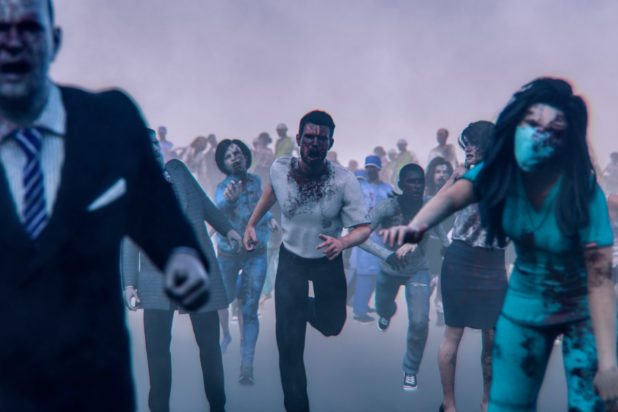Pictured: coronavirus victims trying to overwhelm the nearest hospital.
“Experts” are responsible for getting the government to do this insane lockdown in the first place, alleging that coronavirus is some kind of dangerous menace.
We now know that coronavirus is about as deadly as the flu, but that isn’t stopping the ravenous horde of experts from demanding even more draconian measures to be taken.
They want:
- People to live the
prisonersocial-distancing lifestyle until they’re vaccinated - People to give up most of their social life
- Birthdays, Church, and indoor events banned
- To regulate interactions between people
It is unbelievable how they’re doubling down on the hoax.
Social bubbles could be limited to fewer than ten people and super-spreader indoor events could be banned until well into 2021 to avoid a second peak of coronavirus infections, under scientists’ proposals to government.
Britain could face an ‘exponential growth’ in Covid-19 cases if groups of more than ten are allowed to get together, according to the results of two studies.
The country won’t be able to return to ‘normal’ until a vaccine is found, according to Dr Mike Lonergan, senior author of a study by the Division of Molecular and Clinical Medicine at the University of Dundee.
He told MailOnline the only way lockdown can be safely eased is if people keep only 10 per cent of their former social lives.
‘It doesn’t look like it’s possible to go back to how things were before. It looks hard to believe we’ll do a tenth of the things we were once doing,’ he said.
Weddings, birthdays and funerals could result in the R-rate – the number of people one person can infect – sky rocketing, the Sunday Times reports.
Senior epidemiologist Adam Kucharski has warned Britain could face ‘exponential growth’ in Covid-19 cases if groups of people start getting together for celebrations or religious services.
Dr Lonergan explained that if a person went to the pub every day for ten days before lockdown. Now they could only safely go once.
‘There’s no end point to it. If we want things to be stable they need to be how they are now, in lockdown. This will have to stay until something drastic changes.’
Dr Lonergan said the world was ‘lucky’ social-distancing has been able to curb the virus, because it was ‘barely’ enough.
He added that once the number of infections rises, it will ‘take quite a lot to claw it back’ because the effect of social-distancing on reducing infections has been so slow.
‘Look at where these super-spreading events occur, it’s often at family gatherings and meals and weddings and parties and all these things that socially we want to happen,’ Dr Kucharski told The Sunday Times.
But being outside, for physical activity or even non-contact sports, could be okay because the virus is less likely to spread, the research showed.
‘Going to the park to exercise — that’s something where the transmission risk is probably very low if people are sensible but obviously has enormous health and wellbeing benefits,’ the epidemiologist said.
Dr Kuckarski’s team at the London School of Hygiene and Tropical Medicine found the usual infection rate, known as the R-rate, sees one person spread the virus to an average of three others.
The R-rate currently stands at around 0.7, which crucially falls below the Government goal to keep it below one. The list of five requirements for easing lockdown includes a low R-rate.
But when large groups meet in badly ventilated environments, such as churches, the infection rate soars and the virus spreads three times faster, the study suggests.
The findings mean going to church or celebrating birthdays could put thousands of people at risk because of the increased rate of infections.
But gatherings where people stay at a distance apart from each other and stay outside could be allowed.
…
Dr Kucharski, author of bestselling book about epidemics The Rules of Contagion, said: ‘As soon as measures are lifted, we risk being back where we started, facing exponential growth.’
He added that this meant social distancing restrictions would have to stay in place until at least next year, but ultimately it would be a Government decision.
‘It seems likely that these kinds of close interactions between people will need limitations,’ he said.
The findings of the studies are due to be discussed at a Scientific Advisory Group for Emergencies (Sage) meeting next week.
What action is taken next will be up to the Government and it is still unknown how the UK will exit lockdown, but Dr Kucharski said social distancing is likely to stay in place for some time to come.
Saying that “as soon as measures are lifted, we risk being back where we started” is absolutely malicious and dishonest.
When the lockdown first started, authorities told us that the reason why everyone needed to stay at home was to prevent the virus from spreading too fast and overwhelming the hospitals with infections.
That was it.
It was never intended to keep people isolated until a vaccine was ready.
People assumed that they wanted the virus to spread at a controlled rate so hospitals could treat all of the infections, and that after a few weeks things would start to slowly go back to normal.
Now they’re acting as if coronavirus were some kind of zombie virus.
Rare picture of the coronavirus taunting health care workers.


